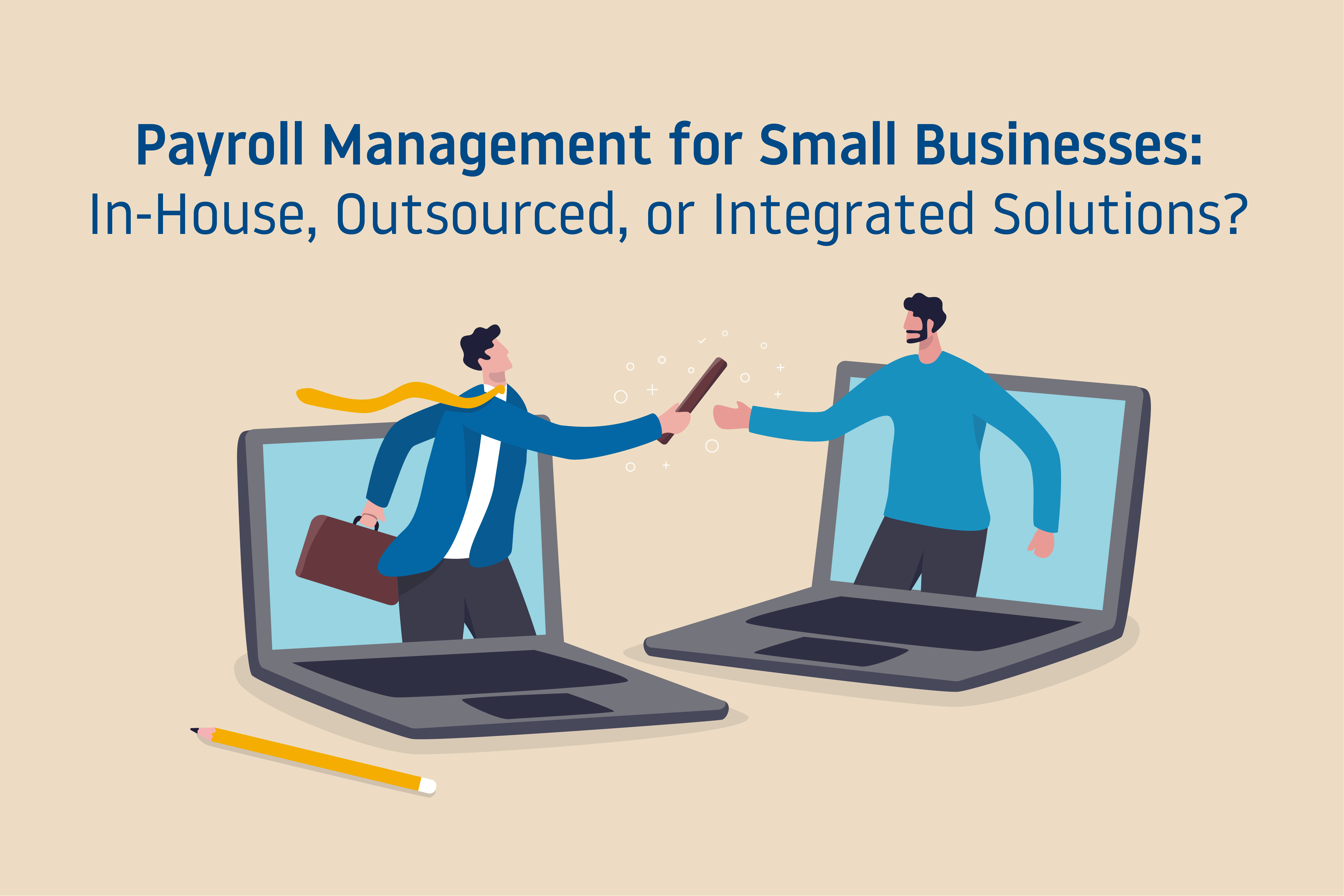Share This Post



Overseeing payroll is a significant aspect of running a small business. The choice between managing payroll internally or outsourcing it, can have a major impact on efficiency, costs, and business operations. And, when it comes to in-house payroll, options vary significantly since integrated solutions fit within this category. Below, we explore the pros and cons of each approach, tailored to the specific needs of small businesses.
In-House Payroll Processing
In-house payroll processing involves handling all aspects of payroll within the company. This can be done using various methods, including manual processes, spreadsheets, or integrated solutions like cloud-based software programs.
Methods of In-House Payroll Processing
- Manual Methods
- Spreadsheets: Using programs like Excel or Google Sheets to track hours worked, calculate pay, and manage employee records.
- Paper Timecards: Employees record their hours manually, which are then used to calculate pay.
- Checking Accounts: Direct payment from the business’s checking account to employees.
- Integrated Solutions
- Cloud-Based Software Solutions: An integrated solution that manages time, attendance, and payroll in one online platform. These can integrate with time clocks or function without them, depending on the business’s needs.
Pros of In-House Manual Payroll Processing
- Control and Flexibility:
- Complete control over payroll processes and data.
- Ability to customize payroll practices to meet specific business needs.
- Immediate access to payroll data for making adjustments or corrections.
- Cost-Effectiveness:
- Avoids the recurring fees associated with outsourcing.
- Potentially lower costs for businesses with simple payroll needs.
- Confidentiality:
- Ensures sensitive payroll information remains within the company.
Cons of In-House Manual Payroll Processing
- Time-Consuming:
- Manual entry and calculations can be tedious and prone to human error.
- Significant time investment required for payroll management, especially as the business grows.
- Compliance Risks:
- Requires staying up-to-date with evolving payroll laws and regulations.
- Risk of costly mistakes if compliance is not maintained.
- Requires Personnel:
- Dedicated personnel or resources are needed for managing payroll. Potential need for additional training or software to ensure accuracy.
Integrated Payroll Processing
Integrated payroll processing involves using comprehensive software solutions that combine various payroll-related functions into a single platform that small business operators can use within the company. They are specifically designed for those who don’t want to outsource their payroll in full. These solutions often include time and attendance tracking, benefits management, and compliance features, all designed to streamline the payroll process.
Pros of Integrated Payroll Processing
- Automation and Efficiency:
- Automated processes reduce the time spent on manual data entry and calculations.
- Streamlines payroll management, making it more efficient and less error-prone.
- Comprehensive Solutions:
- Combines many functions into one cloud-based platform, simplifying management.
- Often includes features like employee self-service portals and real-time reporting.
-
Scalability:
- Easily adapts to the growing needs of the business.
- Can integrate additional modules as required by the business.
- Compliance Management:
- Helps ensure compliance with payroll laws and regulations.
- Reduces the risk of fines and legal issues.
- Cost Savings
- Can oftentimes reduce the costs related to running payroll.
- Avoids costs associated with manual errors, “buddy punching” employee fraud, and potential tax penalties.
Cons of Integrated Payroll Processing
- Initial Setup Costs:
- May require an initial investment for software and training, depending on the software provider.
- Ongoing subscription fees can add to operational costs (However, note above that these can be far cheaper than the cost of alternatives such as outsourcing).
- Learning Curve:
- Staff may need training to effectively use the new system.
- Time required to fully integrate and adapt to the new platform.
- Dependence on Technology:
- Relies heavily on technology and internet connectivity.
- Potential issues with software updates and technical support.
Outsourced Payroll Processing
Outsourcing payroll involves hiring external service providers, such as bookkeepers, accountants, or dedicated payroll service companies to handle payroll tasks. External providers are typically off-site or work remotely from the business.

Types of Outsourced Payroll Services
- Bookkeepers and Accountants:
- Often part of a broader financial management service.
- Can handle payroll alongside other accounting functions.
- Payroll Service Companies:
- Specialize in payroll processing.
- Offer comprehensive services including tax filing, compliance management, and employee self-service portals.
- Outsourced HR Services:
- Provide payroll services as part of a broader HR solution.
- May include benefits administration, recruitment, and other HR functions.
Pros of Outsourced Payroll Processing
- Expertise and Accuracy:
- Access to payroll professionals with expertise in compliance and best practices.
- Reduces the risk of errors and associated penalties.
- Time Savings:
- Frees up internal resources to focus on core business activities.
- Minimizes the administrative burden on small business owners.
- Scalability:
- Easily adapts to business growth and changing payroll needs.
- Providers can offer additional services as the business expands.
- Compliance Assurance:
- Keeps up with changing payroll regulations to ensure compliance.
- Reduces the risk of fines and legal issues.
Cons of Outsourced Payroll Processing
- Costs:
- Recurring and processing fees can add up, particularly for small businesses with tight budgets.
- Costs may increase with additional services or as the business grows.
- There may be extra costs for re-running payroll after corrections are needed.
- Less Control:
- Less direct control or access over payroll processes and data.
- Potential delays in making payroll adjustments or corrections.
- Businesses may need to provide data sooner than planned and may be subject to stringent timelines.
- Confidentiality Concerns:
- Sharing sensitive payroll data with an external provider can raise security concerns.
- Requires trust in the provider’s data protection measures.
Factors to Consider for Small Businesses
When deciding between in-house, outsourced, and integrated payroll processing, small businesses should consider the following factors:
- Business Size and Complexity:
- Small businesses with simple payroll needs and a limited number of employees might find in-house processing more cost-effective.
- As the business grows and payroll becomes more complex, outsourcing or integrated solutions can offer valuable expertise and scalability.
- Budget:
- Evaluate the cost of in-house processing (including time and resources) versus the fees for outsourcing or integrated solutions.
- Consider long-term costs and benefits, not just immediate expenses.
- Compliance and Risk Management:
- Businesses in highly regulated industries may benefit more from outsourcing or integrated solutions to ensure compliance.
- Evaluate the potential risks of payroll errors and non-compliance.
- Time and Resource Availability:
- Small business owners often wear multiple hats; outsourcing or integrated solutions can free up time for more strategic activities.
- Consider the availability of internal resources to manage payroll effectively.
- Technological Needs:
- Businesses that already use integrated, cloud-based software solutions may prefer to keep payroll in-house for greater control and integration.
- Evaluate the technology offered by payroll service providers and how it integrates with existing systems.

Making Sure the Solution Fits Your Business
The decision to either manage payroll internally, hire external services, or use an integrated solution is one of the most important decisions you will make for your small business. In-house processing offers control, flexibility, and potential cost savings but can be time-consuming and risky. Outsourcing provides expertise, time savings, and scalability but comes with recurring costs and less control. Integrated solutions offer automation and efficiency but may require an initial investment and ongoing subscription fees.
Ultimately, the best choice depends on the specific needs, resources, and growth plans of your business. By carefully evaluating the pros and cons of each approach, you can make an informed decision that supports your payroll management needs and alleviates many of the common pain points associated with payroll oversight—allowing you to concentrate on the most important elements of your business, like growing your bottom line and taking care of your team.
If you’d like to learn more about transforming your business with an integrated software solution, let us know. We’re here to help simplify payroll for your business with an integrated time and attendance and payroll solution.